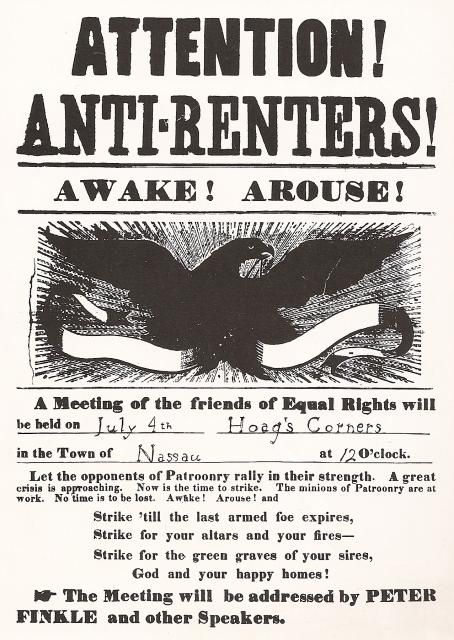
1839 poster supporting the Anti-Rent movement in Nassau, New York. From Wikimedia Commons.
Much about the world has changed in the century and a half since the Anti-Rent War took upstate New York by storm, and the protest movement of the hour is a rather different organism than the bands of "Calico Indians" who once traveled from farm to farm in the Catskills, resisting the evictions of tenant farmers. (For one thing, the Anti-Rent War was bloodier and more confrontational than the mostly nonviolent Occupy Wall Street movement has been so far, and its rhetoric more heated.)
But as this account of the August 7, 1845 killing of Undersheriff Osman Steele by Anti-Rent protestors, written in 1955 and posted today on Bovina historian Ray LaFever's blog, shows, some of the grievances of the Anti-Rent warriors aren't too different from those of today's Wall Street protestors. An excerpt:
Tracts of land in Delaware County were either given by grant or were purchased; and then the owners induced the settlers either to buy or to lease parts of this land from them. Some owners sold their lands to the settlers and made terms of payment such that they could be met. Others gave the settlers leases of their farms, granting the first five years’ use of the land without rent, and then requiring the payment of half of the permanent rent for the second five years, and then after that requiring the payment of full rent. In this way in New York State a few families, intricately intermarried, controlled the destiny of 300,000 people and ruled in almost kingly splendor over 2,000,000 acres of land.
Unfair contracts on homes and lands? Rents soaring above the means of cash-strapped tenants trying to survive in a lean economy? A few well-connected elites controlling the economy and the fates of their feudal underlings? Sound familiar?
Like the Anti-Renters of the nineteenth century, the Occupy Wall Street movement is beginning to get directly involved in foreclosures and evictions. Here's an anonymous poster on the OWS website calling for an immediate end to foreclosures in New York State:
Every week in New York City, in all five boroughs, homes are put up for auction and sale. Speculators purchase homes at discounted rates and flip them. Banks buy back homes to balance their books, evicting the homeowners and letting the homes lie vacant.
Wall Street is the cause of this systematic displacement of New Yorkers. Wall Street bankers turned mortgages into “securitized instruments” and sold them for profit. Their greed demanded the creation of more and more mortgage-backed securities. Without blinking, they used predatory loans to lure homeowners into mortgages with impossible—and unseen—interest rates.
Occupy Wall Street and Organizing for Occupation (the group that led the eviction blockade at Mary Lee Ward’s Bed-Stuy home on August 19, 2011) have teamed up to raise awareness about the weekly auctions and to hold Wall Street accountable for the foreclosure crisis!
Gudiel set off a massive protest and media frenzy when people got wind of the foreclosure of her home, which Guidel has shared with her disabled mother and other relatives for ten years. A coalition of activists kept a round-the clock vigil outside the Bel-Air mansion of the president of OneWest Bank that had initiated foreclosure proceedings. From there, they moved to the sidewalk outside Fannie Mae's office in Pasadena, after discovering the government-sponsored lender had taken over Gudiel's loan. Another group surrounded Gudiel's house, pledging to risk arrest if sheriff deputies tried to evict the family, including her wheelchair-bound mother.
Police arrested Gudiel and five others when they refused to leave. In the end, Gudiel prevailed, bank executives relented and she remains in her house.
Gudiel's is a happier story than the one that unfolded on Moses Earl's farm in Andes in 1845, which left Undersheriff Steele dead from his wounds from three musket balls, Delaware County declared to be in a "state of insurrection," and nearly a hundred anti-renters convicted of various crimes.
But in the end, the Anti-Rent warriors prevailed. In 1846, sympathizer John Young was elected governor of New York State, and he pardoned all of the Anti-Renters still in jail, and put an end to the quasi-feudal system that governed agricultural leases in New York State. Another excerpt from LaFever's blog:
The result of the anti-rent agitation was that new laws were enacted, which cured some of the evils of the lease-hold system. The tenants were able to buy, at easy prices, the soil of the land they had tilled and occupied. But this affair created bitter feeling and animosities in the town of Bovina that took years to remove. Business men, in sympathy with the landlords, were boycotted and, thus, driven from town.
It's anyone's guess what the Anti-Rent farmers would have had to say for themselves on the internet, if it had been around in 1845. But no doubt it would have been an eye-opening read. Here's a Tumblr blog called We Are The 99 Percent, on which many of the people involved in the Occupy Wall Street movement have been telling their personal stories about trying to get by in a disastrous economy.











